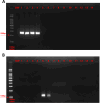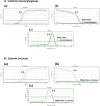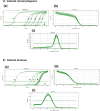Novel primers drive accurate SYBR Green PCR detection of Listeria monocytogenes and Listeria innocua in cultures and mushrooms
- PMID: 39779768
- PMCID: PMC11711378
- DOI: 10.1038/s41598-024-81508-6
Novel primers drive accurate SYBR Green PCR detection of Listeria monocytogenes and Listeria innocua in cultures and mushrooms
Abstract
The close genetic resemblance between Listeria monocytogenes and Listeria innocua, combined with their presence in similar environments, poses challenges for species-specific detection in food products. Ensuring food safety through microbiological standards necessitates reliable detection of pathogens like L. monocytogenes and L. innocua throughout the food chain using appropriate analytical techniques. This study aims to develop, identify, and validate a SYBR Green qPCR-based genetic marker designed to detect L. monocytogenes and L. innocua. By performing a comparative analysis of the complete genome sequences of L. monocytogenes (ATCC 12392) and L. innocua (CFSAN044836), a unique gene region encoding a hypothetical protein with an LPXTG cell wall anchor domain (GCF_003031895.1) in L. monocytogenes and leucine-rich repeats (GCF_009648575.1) in L. innocua was identified. Primers targeting these specific region were designed and validated for their effectiveness in detecting L. monocytogenes/L. innocua using both conventional PCR and qPCR techniques. These primers exhibited high sensitivity and specificity in amplifying L. monocytogenes and L. innocua among different Listeria species. The sensitivity and specificity of the primers were further confirmed through standard curve analysis using three different templates: cloned DNA (as a positive control), genomic DNA, and bacterial cell suspension. Additionally, the primers were rigorously tested and validated for their accuracy in directly detecting the targeted strains in live enoki mushroom samples. This direct qPCR method offers significant advantages for the rapid and precise detection of L. monocytogenes and L. innocua, potentially enhancing the efficiency of diagnostic and monitoring processes within food and vegetable distribution systems.
Keywords: L. Innocua; L. monocytogenes; Detection; Primer design; Quantification; qPCR.
© 2025. The Author(s).
Conflict of interest statement
Declarations. Competing interests: The authors declare no competing interests.
Figures





Similar articles
-
Quantitative detection of Listeria monocytogenes and Listeria innocua by real-time PCR: assessment of hly, iap, and lin02483 targets and AmpliFluor technology.Appl Environ Microbiol. 2004 Mar;70(3):1366-77. doi: 10.1128/AEM.70.3.1366-1377.2004. Appl Environ Microbiol. 2004. PMID: 15006755 Free PMC article.
-
Detection and quantification of the iap gene of Listeria monocytogenes and Listeria innocua by a new real-time quantitative PCR assay.Res Microbiol. 2001 Jan-Feb;152(1):37-46. doi: 10.1016/s0923-2508(00)01166-9. Res Microbiol. 2001. PMID: 11281324
-
Development and validation of qualitative SYBR®Green real-time PCR for detection and discrimination of Listeria spp. and Listeria monocytogenes.Appl Microbiol Biotechnol. 2013 May;97(9):4021-37. doi: 10.1007/s00253-012-4477-2. Epub 2012 Oct 20. Appl Microbiol Biotechnol. 2013. PMID: 23086339 Free PMC article.
-
A review of the ecology, genomics, and stress response of Listeria innocua and Listeria monocytogenes.Crit Rev Food Sci Nutr. 2012;52(8):712-25. doi: 10.1080/10408398.2010.507909. Crit Rev Food Sci Nutr. 2012. PMID: 22591342 Review.
-
Application of Comparative Genomics for the Development of PCR Primers for the Detection of Harmful or Beneficial Microorganisms in Food: Mini-Review.Foods. 2025 Mar 20;14(6):1060. doi: 10.3390/foods14061060. Foods. 2025. PMID: 40232097 Free PMC article. Review.
References
-
- Rodriguez, C., Taminiau, B., García-Fuentes, E., Daube, G. & Korsak, N. Listeria monocytogenes dissemination in farming and primary production: Sources, shedding and control measures. Food Control120, 107540 (2021).
Publication types
MeSH terms
Substances
LinkOut - more resources
Full Text Sources
Molecular Biology Databases

